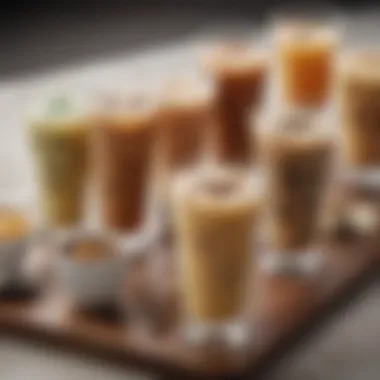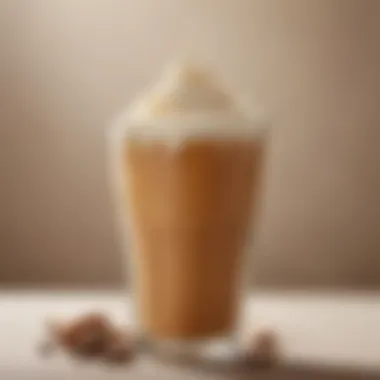Milk Tea Culture: A Global Perspective


Intro
Milk tea, a drink that has woven itself into the cultural fabric of societies around the world, goes far beyond its simple ingredients. This article delves into the fascinating realm of milk tea culture, exploring its origins, the diverse flavor profiles that vary by region, and its contemporary significance as a social catalyst. The drink, once a humble concoction of tea and milk, has evolved into an artistic expression, a way for people to connect, and a symbol of cultural identity.
Milk tea's journey starts in the warm climates of Asia, blossoming into unique forms across various nations like Taiwan, India, and Thailand. Each place infuses its own characteristics; for example, in Taiwan, the iconic bubble tea features chewy tapioca pearls, while in India, chai is masala-infused and served steaming hot. This article will highlight the key features of milk tea culture that make it a global phenomenon, as well as the sense of belonging it fosters among 'milk tea people.'
As we embark on this exploration, you'll discover the essential ingredients that form the base of this refreshing drink, the artistry behind its preparation, and the communal experiences that revolve around enjoying a cup.
"Milk tea reflects the shared experiences of communities, transcending language and borders."
Whether you're a connoisseur or a casual sipper, understanding the nuances of milk tea will enrich your appreciation of this captivating beverage. Let’s begin our journey!
Prelude to Milk Tea
Milk tea is more than just a drink; it's a rich blend of history, culture, and community. This section serves as the gateway into understanding not only what milk tea is but also the journey it undertook to become a widely beloved beverage around the globe. From bustling city cafes to quiet corners of homes, milk tea plays a pivotal role in connecting individuals and cultures. Its unassuming nature belies a complex web of traditions, flavors, and social interactions that deserve careful exploration.
Defining Milk Tea
So, what exactly is milk tea? At its core, milk tea is a combination of black or green tea mixed with milk or a milk substitute. The essence of this drink varies significantly from one culture to another, with countless recipes and techniques passed down through generations. In some regions, milk tea is simple and straightforward, just brewed tea with a splash of milk. In others, it represents a more elaborate infusion, featuring spices like cinnamon or cardamom, or even sugary components like condensed milk.
In essence, milk tea is not just one drink; it encompasses a myriad of styles and adaptations that make it uniquely appealing. It's comforting and invigorating, a balm after a long day and a boost during social gatherings.
Origins and Evolution
Tracing back the origins of milk tea reveals a meandering path, dotted with cultural exchanges and local inventions. While some attribute its roots to China as early as the Tang Dynasty, others argue that milk tea found its way to the West through British colonial influence during the early 19th century. Those familiar with Hong Kong’s iconic milk tea know that it bears a deep connection to British colonialism, where tea culture enjoyed a renaissance through the fusion of Chinese and British styles.
As people carried their tea traditions across borders, they incubated new customs that reflected local tastes and ingredients. In Taiwan, for instance, the advent of bubble tea in the 1980s marked a pivotal evolution, introducing chewy tapioca pearls that mesmerized a younger generation. This drink revolutionized the entire milk tea arena, paving the way for incessant experimentation and creativity.
Milk tea continues to evolve today, with innovative flavors such as matcha, taro, and fruit-infused variations appealing to diverse demographics. The drink has morphed into a symbol of globalization, where each cup represents a unique story, a blend of cultural narratives and individual creativity, ultimately crafting a mosaic that celebrates diversity in every sip.
"Milk tea is a canvas waiting for each culture to paint its story on, resulting in countless interpretations that speak to local identities."
Understanding the story behind milk tea enriches our appreciation for it, shedding light on its role as a social offering and its place in various rites of passage across cultures. Whether sipped at afternoon tea in England or enjoyed in a lively bubble tea shop in Southeast Asia, milk tea dances gracefully through the pages of history and into our daily lives.
Cultural Significance of Milk Tea
Milk tea holds a unique place in culinary traditions across diverse cultures. Not just a beverage, it symbolizes connection, heritage, and an evolution of social customs. Through this lens, we can examine how milk tea fosters relationships and bridges cultural divides, while also celebrating the regional specificities that contribute to its rich tapestry.
Milk Tea as a Social Connector
In many cultures, sharing a cup of milk tea is more than about quenching thirst; it is a ritual that reinforces bonds. For instance, in Taiwanese night markets, patrons line up at bubble tea stalls, engaging in lively conversations while awaiting their orders. Here, milk tea becomes a catalyst for social interaction. The element of customization—choosing flavors, sweetness levels, and toppings—encourages dialogue, as friends exchange opinions on their preferences.
Milk tea's role as a social facilitator transcends geographic boundaries. A brief visit to Southeast Asian homes often reveals a welcoming cup of milk tea offered to guests. It embodies hospitality and warmth, allowing individuals from different backgrounds to share stories and experiences. This beverage cultivates a sense of belonging and community, making it a staple in social gatherings, celebrations, and everyday life. In short, milk tea carries the unspoken message of connection across dinner tables and cafes.
Regional Variations and Cultural Identity
Regional variations of milk tea demonstrate how local cultures have uniquely shaped this drink. From East Asian boba to frothy teas in Southeast Asia, each adaptation reveals rich narratives of tradition and identity.


East Asian Variants
In East Asia, particularly Taiwan and Hong Kong, milk tea isn't just a drink; it reflects a cultural mindset. Bubble tea, a creation from Taiwan, stands out with its chewy tapioca pearls, attracting fans worldwide. This variant highlights creativity through its textured experience, which contrasts with the smoothness of milk tea itself. Its popularity stems not only from taste but also from the social phenomenon surrounding it—people gather at bubble tea shops to sip and share.
Moreover, the craftsmanship involved in brewing strong black tea combined with milk showcases a commitment to quality. It's not just about satisfying a thirst; it's about partaking in a shared culture that encourages exploration of flavors. The downside? The dependence on sugary toppings can raise eyebrows for the health-conscious.
Southeast Asian Influences
Traveling through Southeast Asia, one encounters a different take on milk tea, often infused with spices and served over ice. Thai milk tea, rich with sweetened condensed milk, offers a sweet escape from the heat, showcasing the region’s culinary creativity. The blend of strong Ceylon tea and a balance of creamy sweetness creates a unique flavor profile that resonates with locals and tourists alike.
This regional take enhances the already rich experience of consuming milk tea. However, its rich sweetness may not appeal to everyone, demanding an acquired taste. Yet, it embodies a fusion of culture's subtle complexities: spice represents flavor while milk brings comfort, a reflection of how interconnected cultural identities can be.
Western Adaptations
In the West, milk tea has morphed further, incorporating elements of local coffee culture. With cafes popping up across cities, you find milk tea featured alongside traditional coffee, tapping into a growing market seeking variety. Here, the emphasis often shifts to innovative flavors—lavender, matcha, or even turmeric lattes blending the essence of milk tea with a modern twist.
This adaptation underscores a refreshing embrace of global influences while catering to evolving palates. While the presentation often looks more chic, it might lose some authenticity that enthusiasts cherish. Nevertheless, it brings milk tea to a new audience who may have never imagined incorporating tea in such diverse ways.
The Milk Tea Global Phenomenon
The rise of milk tea as a beloved beverage goes beyond just a drink; it's a global phenomenon that showcases how food and culture intertwine. In recent years, the popularity of milk tea has exploded across continents, reflecting a wider trend in culinary globalization. The dynamics between traditional tea cultures and modern consumer preferences have created a space where milk tea thrives, making it a hot topic for food lovers and industry analysts alike.
Market Growth and Demand
The market for milk tea is experiencing exceptional growth. Several factors contribute to this uptick, prominently the embrace of diverse flavors. Consumers are no longer just seeking traditional black tea with milk; they want unique spins that surprise and delight their palates. For example, bubble tea shops are flourishing in urban centers worldwide, often offering customized experiences where patrons can pick the types of teas, flavors, and toppings to suit their individual tastes. This ability to personalize is driving demand.
Notably, market analysis indicates that the global bubble tea market, valued at several hundred million dollars, is projected to grow exponentially over the next few years. Young adults, particularly between 18 and 34 years, are at the center of this trend. They not only consume milk tea regularly but also advocate for it on platforms like Instagram and TikTok, promoting their go-to spots and concoctions.
Trends in Consumption
Health Conscious Choices
As consumers become more health-savvy, Health Conscious Choices in milk tea have gained traction. People are increasingly looking at ingredients, preferring less sugary options or those made with natural sweeteners. Many shops now offer alternatives like oat milk or unsweetened iced tea bases, catering to dietary restrictions or preferences. This shift is fueled by a desire for beverages that satisfy taste buds while also being mindful of caloric intake and overall health.
The key characteristic of health-conscious milk tea is variety in selections. On one hand, consumers can indulge in popular flavors like caramel or matcha; on the other hand, they can opt for lighter alternatives. This flexibility has become a hallmark of many specialty shops. Nutrition-focused messaging also enhances the appeal of these beverages, enhancing their status as not only treats but also functional drinks.
Innovative Flavors and Ingredients
The imprint of Innovative Flavors and Ingredients cannot be overlooked in the milk tea wave. As a consumer, the experience of indulging in flavors beyond the traditional has transformed the milk tea landscape. From exotic fruit blends like passionfruit and lychee to unique fusions with spices like cardamom, milk tea establishments are continually experimenting. These innovations keep the beverage not only fresh and exciting but also encourage repeat visits.
What stands out in this aspect is the creativity in combining different elements. For instance, some shops now offer cheese foam as a topping, adding a savory twist to the sweetness of milk tea. The advantages of these developments are clear; they draw in adventurous customers ready to try the latest trends. However, there are potential drawbacks, as overcomplicated menus could alienate those seeking a more classic drink experience. Overall, though, the exploration of flavors is a driving force in broadening the appeal of milk tea on a global scale.
"The milk tea phenomenon exemplifies how tradition and modernity can blend seamlessly, creating beverages that reflect cultural exchanges."
Demographics of Milk Tea Enthusiasts
Understanding the various demographics of milk tea enthusiasts is not just an academic exercise; it's a lens through which we can observe the convergence of cultural trends, consumer behavior, and social connections. By breaking down who enjoys milk tea and why, we uncover layers of preferences and motivations that reveal how this simple drink has become a social phenomenon. This section serves as a bridge to explore the intricate tapestry of communities that rally around milk tea, each with its own distinct flavors, customs, and stories.


Understanding the Milk Tea People
The demographic landscape of milk tea lovers is as diverse as the beverages themselves. It encompasses a wide age range that includes teenagers seeking trendy flavors as well as adults who cherish its comforting qualities. Notably, young adults often fuel the bulk of the demand. For example, between the ages of 18-35, many individuals are drawn to the aesthetic qualities and Instagrammable presentation of milk tea, often seen waving neon-colored drinks through vibrant local cafes. This age group documents their experiences on social media platforms, thus reinforcing a sense of community.
"Milk tea isn’t just a drink; it’s a story, a moment captured in time."
Milk tea’s reach doesn't stop with young adults. Older generations also find comfort in traditional brews that evoke nostalgia, bridging the gap between the modern and the classic. Understanding these subgroups sheds light on why certain trends emerge and why others fade away, enhancing our comprehension of the milk tea culture.
Psychographics and Preferences
Taste Preferences
When it comes to taste, milk tea aficionados display an interesting array of preferences. Some swear by the classic black milk tea, hailing from the street stalls of Hong Kong, while others chase after the adventurous flavors like taro and matcha. This broad spectrum of choices serves to illustrate the vibrant character of the tea culture.
One key characteristic of these preferences is the inclination toward customizing one's drink—adding different layers of sweetness or a dash of cream to tailor to personal taste. This customization not only enhances the individual experience but also reflects a deeper desire for personal expression. While some may argue that too much choice can lead to decision fatigue, the ability to craft one's beverage empowers enthusiasts to engage more meaningfully with their drink.
Social Media Influence
In today’s digital age, social media plays a monumental role in shaping the preferences of milk tea enthusiasts. Platforms like Instagram and TikTok brim with visuals and videos showcasing unique milk tea creations— rich hues, bubble tea pearls, and decorative toppings. The interaction these posts generate becomes a catalyst for the collective enthusiasm, as users share experiences and recommendations.
One of the key characteristics of social media influence is its ability to create trends at an astonishing speed. For instance, new flavors can skyrocket to popularity overnight simply by going viral. However, while this aids quick consumption of information and trends, it also brings about a sense of superficiality, as some may prioritize aesthetics over flavor quality.
To summarize, the demographics of milk tea enthusiasts unveil a framework that encapsulates not only age and preference but also the deeper psychological motivations that drive consumer choices. As we continue to dissect this fascinating culture, it becomes clear that milk tea is more than just a thirst quencher; it is interlaced with the narratives of its drinkers.
Preparation and Craftsmanship
The heart of milk tea lies not only in its unique flavors but also in the art and care that goes into its preparation. Understanding the nuances of preparation and craftsmanship is essential, as it distinguishes a good cup of milk tea from a remarkable one. This section highlights how traditional methods blend with modern innovations, shaping not just the beverage but also the experiences surrounding it.
Traditional Brewing Methods
Traditional brewing methods are steeped in history and cultural significance. Across various regions, these practices reflect the local customs, flavors, and techniques passed down through generations. For instance, consider the practice of steeping black tea leaves in boiling water before adding milk and sugar—a ritual common in many Asian cultures. This method not only requires precision but also an understanding of the perfect brew time to coax the full flavor from the tea leaves. Each cup made this way carries a legacy, making the drinking experience richer and deeper.
Traditional methods also embrace the physical elements involved, such as the vessels used, be it ceramic teapots or glass jars. The materials can enhance the flavor, creating a more holistic engagement with the drink. Chemical reactions occur differently based on the temperature, type of milk, and even the method of stirring.
Modern Innovations in Milk Tea Preparation
Bubble Tea Trends
Bubble tea, or boba, has taken the world by storm, introducing a playful and interactive element to the milk tea experience. Originating from Taiwan, this drink features chewy tapioca pearls that burst with flavor, adding texture and excitement. The allure of bubble tea lies not just in its unique characteristics, but also in its adaptability. Cafés around the globe have put their spin on it, offering an assortment of flavors and toppings.
One key characteristic of bubble tea is its customizable nature. Customers can choose everything from the type of tea base—be it green, black, or even herbal—to a range of flavors like taro, matcha, or fruit-infused options. Yet the advantages also come with challenges; the preparation requires precise timing to cook the boba perfectly, where overcooking can lead to a mushy texture, and undercooking can result in a tough chew. Understanding this balance is critical, emphasizing the craft behind each serving.
DIY Milk Tea Recipes
The rise of DIY milk tea recipes reflects an increasing desire for personalization in our culinary experiences. This approach allows enthusiasts to experiment with ingredients and flavors, catering to individual tastes and dietary preferences. With basic essentials like tea, milk, and sweeteners, anyone can create their unique concoction right at home. The charm of DIY recipes lies in their simplicity and accessibility.
One standout feature is the plethora of online resources available for guidance. From instructional videos to community forums on platforms like Reddit and Facebook, milk tea lovers share tips and tricks for perfecting their brews, so it's a dynamic culture. However, the downside is that the quality can vary widely based on available ingredients and one's own skill level.


Experimentation can lead to delicious surprises, or sometimes a cup of regret, but it's all part of the fun of crafting your own milk tea.
Whether you’re brewing with traditional methods or diving into the modern bubble tea craze, the journey of preparation in milk tea culture is a rich tapestry of practice, intuition, and personal expression. Each cup holds the promise of flavor tailored to one's preference, making it, at its essence, more than just a drink—it's a craft.
Nutritional Insights
As we sip on our creamy concoctions, it’s not just about the taste; the nutritional aspects hold their own weight in understanding milk tea culture. This section serves as a window into what milk tea can bring to the table, literally and figuratively. With a blend of flavors comes a buffet of ingredients, each contributing to different health outcomes. Knowing what goes into that cup can give us pointers on how to enjoy it in a more beneficial manner.
Understanding Ingredients
To truly appreciate milk tea, one must first get acquainted with its key ingredients. Typically, milk tea consists of brewed black tea or green tea, milk (or a milk alternative), and sweeteners. However, the unearthing reveals a much broader spectrum.
- Tea Varieties: The choice of tea can vary between black, green, oolong, or even herbal. Each carries its own set of antioxidants, contributing different health benefits.
- Milk Options: Historically, cow’s milk has been a staple in milk tea, but now choices like almond, oat, or soy milk are getting their time in the spotlight.
- Sweeteners: From cane sugar to honey, agave syrup, or even stevia, the selection of sweeteners plays a crucial role in the nutritional profile of milk tea.
Understanding these ingredients and their impact on health empowers consumers to make informed choices. You can opt for a low-calorie option while still enjoying your favorite beverage, ensuring your milk tea serves a dual purpose of both taste and nutrition.
Health Benefits and Considerations
Caffeine Content
Caffeine in milk tea is a compelling aspect that’s often overlooked but highly engaging. Primarily coming from the tea leaves, it integrates well into the overall experience of drinking milk tea. Not only does it provide an energizing boost, but caffeine is also linked to various health benefits. For example, studies suggest that moderate caffeine consumption could enhance cognitive function and boost metabolism.
- Key Characteristic: Many individuals enjoy caffeine for its stimulating effects, making this drink an ideal choice to kickstart your day or perk you up in the afternoon slump.
- Advantages: Consuming milk tea with its moderate caffeine content can bring about increased alertness and improved mood, which many find appealing in a fast-paced world.
- Disadvantages: However, too much caffeine can lead to jitters or affect sleep patterns, so it’s essential to strike a balance that works for you.
Sugar Levels and Alternatives
Sugar is arguably one of the most contentious ingredients in any drink, including milk tea. It's essential to decipher the nuances surrounding sugar levels and alternative sweeteners which play a significant role in dairy concoction.
- Key Characteristic: A standard serving of milk tea can pack in significant sugar, especially with certain dessert-style versions. This is a concern for many health-conscious individuals.
- Benefits of Alternatives: Utilizing sugar substitutes like monk fruit or stevia can drastically cut down calorie intake while still sweetening your drink. For those keen on health yet unwilling to compromise on flavor, these alternatives become a game-changer.
- Disadvantages: Still, not all sugar alternatives react well with everyone’s digestive system. Some may experience gastrointestinal discomfort, prompting the need for personal testing and adjustment.
"The magic of milk tea lies in not just how it tastes but how it fits into the greater picture of our health and lifestyle choices."
Recognizing the nutritional content, alongside careful consideration of your specific health needs, elevates the experience of engaging with milk tea beyond mere enjoyment. Armed with this knowledge, you can navigate through the choices in this curated drink and indulge mindfully.
Closure
Milk tea's journey through time and across cultures underscores its significance beyond a mere beverage. This article has navigated through the intricate layers of milk tea, highlighting its role as a social lubricant and an avenue for cultural exchange. The warming drink embodies community, transcendence of regional barriers, and even personal identity.
Reflecting on Milk Tea's Role in Modern Culture
In today’s fast-paced world, milk tea sits at the intersection of convenience and pleasure. It's more than just the creamy concoction favored by many; it represents a cultural marker. Each sip can provoke fond memories from shared experiences, whether it’s a casual chat with friends at a bubble tea shop or the comforting taste from a family recipe. Moreover, recent years have pushed milk tea into the global spotlight as diverse cultures intertwine, showcasing flavors that reflect both authenticity and innovation. For instance, while some may opt for traditional Hong Kong milk tea, others might delight in unique fusion flavors like matcha-mango, providing an exciting twist.
It's imperative to recognize how milk tea embodies modern social interactions and its presence in social media realms, where milk tea shops use Instagram as their canvas, painting vibrant drinks that beckon a click. As such, the world of milk tea continually evolves, helping to sustain its vibrancy amidst changing trends.
Future Trends in Milk Tea Consumption
Looking ahead, there’s much to anticipate in the realm of milk tea. First, health-conscious consumers are reshaping the landscape, seeking lower sugar options and plant-based ingredients. This shift could see a rise in the popularity of alternatives like oat milk or even adapting fruit-based teas to cater to evolving health needs.
Additionally, technology may further enhance the experience. From mobile app ordering to automated brewing systems, convenience will likely play a huge factor in how consumers interact with their milk tea. Moreover, more flavors and seasonal offerings might emerge, enticing enthusiasts to broaden their palates.
"Milk tea's endless adaptability ensures it remains relevant, continually inviting new fans to its ever-expanding universe."
As cultures increasingly influence one another, we may witness milk tea innovations inspired from a multitude of culinary backgrounds.







